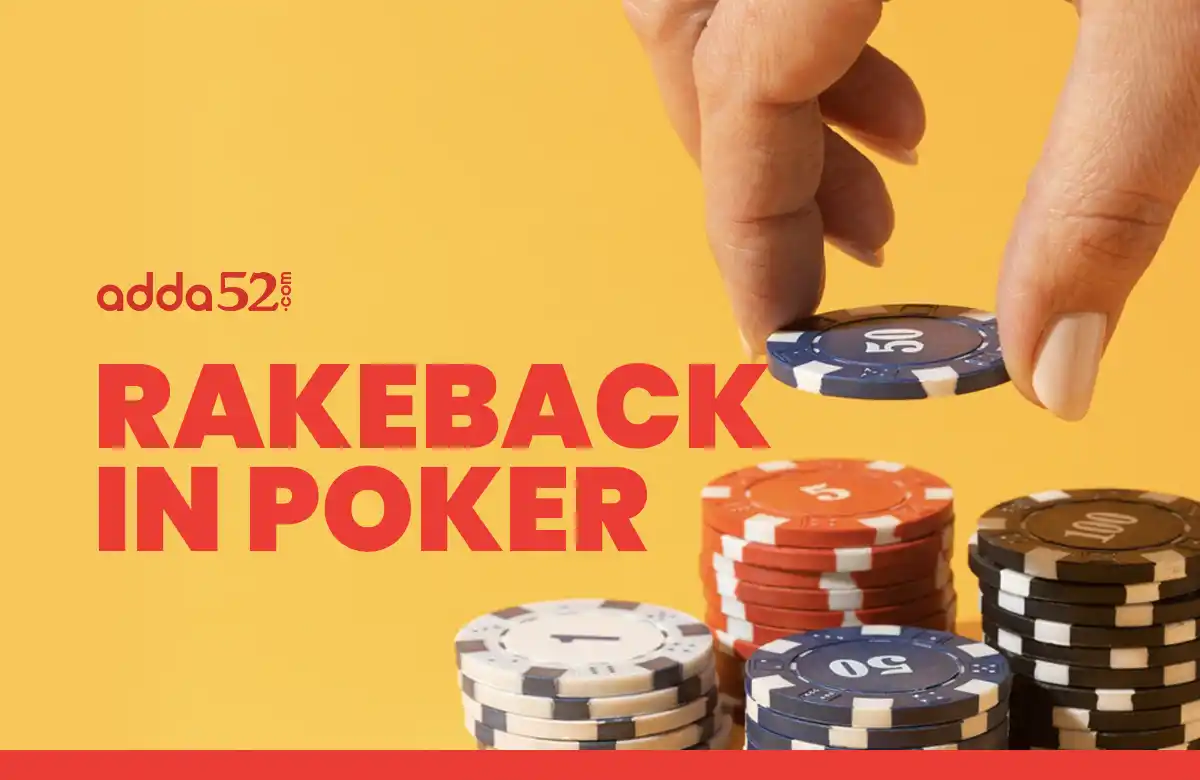
If you are playing online Poker, rakeback is a term you cannot overlook. It is one of the most attractive incentives offered by Poker platforms, as it encourages loyalty and increases player retention.
In this article, we will explore what rakeback is and its advantages.
What is Rakeback in Poker?
Rakeback is a cashback program implemented by Poker platforms to reward players. It refunds part of the rake they pay while playing, offsetting this operational cost for hosting Poker games. This system mainly benefits high-volume players who accumulate large amounts of rake, helping to ease their financial burden. This return can be provided in different ways, such as direct cash, tournament tickets, or rewards points convertible to money or prizes.
How Does Rakeback Work?
A rake is like a small fee the poker sites take from each pot. A rakeback is when the site gives you some of the fees back.
Every time you play a real money hand, the platform takes a percentage of the pot as a rake. If you qualify, you get back a percentage of the rake over time. If you paid $100 and the site pays 30% rakeback, you get $30. In tournaments, you might get a bonus or a rakeback based on the entry fee you paid.
How to Calculate Poker Rakeback?
There are three ways to calculate poker Rakeback:
Contributed Rakeback
A contributed rakeback is when you get a portion of the money you have contributed to the pot. If the pot is $100, the winner will get $40, and the house will get $5 as rakeback. You will get $2 as a rakeback.
Progressive Rakeback
In progressive rakeback, the rakeback increases as you play more hands. This rakeback rewards players who play more frequent hands and generate more rake. This incentivises players and encourages them to play more.
Dealt Rakeback
Irrespective of whether you contributed to the pot, you get a percentage of the rake generated by the hands you are dealt. The rake amount is based on the percentage of hands you are dealt rather than the amount of rake you have contributed.
Why is Rakeback Important?
Offsets the Cost of Rake
Rakeback reduces the effective cost of playing poker. Over time, the cashback can add to a player’s earnings.
Improves Profitability
For regular players, rakeback can turn a break-even session into a profitable one or enhance already profitable results.
Encourages Player Loyalty
Rakeback incentives motivate players to stick with a specific poker room, especially those offering higher percentages or lucrative loyalty programs.
Sustains Bankrolls
Rakeback helps players stretch their bankrolls further by returning a portion of the rake, allowing for more games and longer play sessions.
Types of Rakeback Programs
Flat Percentage Rakeback
Players receive a fixed percentage of the rake they generate. This system is straightforward to understand.
Example:
- If you pay ₹5,000 in rake and the platform offers 20% rakeback, you receive ₹1,000 back.
Tier-Based VIP or Loyalty Programs
Players climb through tiers based on the rake they generate. Higher tiers offer better rewards.
Example:
- Bronze Tier: 10% rakeback.
- Silver Tier: 20% rakeback.
- Platinum Tier: 40% rakeback.
Time-Limited Promotions
Poker rooms often run promotional events where rakeback percentages are temporarily boosted.
Example: A poker room offers 50% rakeback weekly during a Diwali special. If you generate ₹10,000 in rake during this period, you receive ₹5,000 back.
Affiliate Rakeback Deals
Players who register through affiliates may gain access to exclusive rakeback deals, often with higher percentages than standard offers.
Reward Point Systems
Some platforms credit reward points based on the generated rake instead of direct cash. These points can be redeemed for cash, tournament entries, or merchandise.
Methods of Rakeback Calculation
Contributed Rake
Players earn rakeback based on their contribution to the pot.
Example:
- In a ₹1,000 pot with ₹50 rake, if you contributed ₹400, your share of the rake is: ₹50 × ₹400/₹1,000=₹20
- With a 30% rakeback rate, you earn ₹20 × 30%= ₹6.
Dealt Rake
The rake is divided equally among all players dealt into the hand, regardless of their contribution.
Example:
- In a 6-player hand with ₹60 rake, each player’s share is: ₹60 ÷ 6 = ₹10.
- With a 30% rakeback rate, you earn ₹10 × 30% = ₹3.
Weighted Contributed Rake
Like the contributed rake method, it gives more weight to players who contribute larger amounts to the pot.
How to Maximise Your Rakeback
Here’s how you can make the most of rakeback programs:
Choose Platforms with High Rakeback Offers
Not all Poker platforms are equal in their rakeback offerings. Some provide flat percentages, while others have tiered programs or time-limited promotions. Read the terms and conditions to understand calculation methods and eligibility requirements.
Play High-Volume Games
The more you play, the greater your rake generation becomes, which leads to increased rakeback. Playing multiple tables simultaneously can further boost your playing volume and rakeback earnings.
Participate in Promotions
Poker platforms frequently run promotional events with enhanced rakeback rates or special cashback deals. These are excellent opportunities to maximise your rewards.
Climb Loyalty Tiers
Many platforms operate tier-based loyalty programs where higher tiers offer better rakeback percentages or additional perks. Aim to play consistently and generate enough rake to advance to the higher tiers.
How to Maximise:
- Track your rake generation and ensure you meet the criteria to maintain or upgrade your tier.
- Focus your play on a single platform to climb faster.
Utilise Affiliate Rakeback Deals
Signing up for Poker rooms through affiliate links often grants access to exclusive rakeback deals. These deals may offer higher percentages or additional bonuses unavailable through standard registration.
Play Rake-Efficient Games
Some games have lower rake structures than others. Focus on these games to reduce the overall rake you pay, indirectly boosting your rakeback as a percentage of your costs.
Examples of Rake-Efficient Games:
- Short-handed tables (6-max) often generate less rake per player than full-ring tables.
- Low-stakes games may have lower rake caps than high-stakes games.
Understand the Rakeback Calculation Method
Different platforms use various methods to calculate rakeback, such as contributed rake, weighted contributed rake, or dealt rake. Knowing how your platform calculates rake can help you adjust your playing strategy.
Examples:
- In a contributed rake system, play more hands where you actively contribute to the pot.
- In a dealt rake system, being dealt into more hands boosts your rakeback.
Leverage Reward Points
Some platforms offer reward points instead of direct rakeback. These points can often be redeemed for cash, tournament tickets, or merchandise. Maximise the use of these points by converting them into the highest-value items.
Track Your Rake and Rakeback
Keep a record of the rake you generate and the rakeback you receive. Use tracking software or poker room tools to monitor your progress. This helps you:
- Ensure you are receiving the correct rakeback amount.
- Identify opportunities to improve your gameplay volume or loyalty tier.
Avoid Rakeback Deductions
Some platforms deduct bonuses, freerolls, or tournament overlays from your rakeback calculation. Understand these deductions and adjust your playing or claiming behaviour to minimise their impact. If rakeback is reduced when using deposit bonuses, time your deposits to avoid overlap.
Explore Multi-Platform Play
Focusing on a single platform can help climb loyalty tiers, but you might find better rakeback deals on other platforms. Compare and consider splitting your play if it increases your rakeback earnings. Ensure you play enough volume on each platform to qualify for their rakeback programs.
Examples of Rakeback Promotions
- Platform A:
- Offers flat 25% rakeback.
Example: If you generate ₹12,000 in rake, you receive ₹3,000 back.
- Platform B:
- Features a tiered VIP program:
Bronze: 10% rakeback.
Silver: 30% rakeback.
Gold: 50% rakeback.
Example: A Gold-tier player generating ₹20,000 in rake earns ₹10,000 back.
- Platform C:
- Runs seasonal promotions with 50% rakeback during major festivals like Diwali.
Example: Raking ₹15,000 during the promotion yields ₹7,500 in rakeback.
Frequently Asked Questions
What is rakeback in Poker?
Rakeback is a reward system where poker platforms return a percentage of the rake (commission) players pay during games. It helps offset the cost of playing poker, increasing profitability for both casual and professional players.
How is rakeback calculated?
Rakeback is calculated as a percentage of the rake a player generates. For example, if you generate ₹10,000 in rake and the rakeback rate is 20%, you will receive ₹2,000 back. Calculation methods include flat percentages, contributed rakes, or loyalty points.
How does rakeback benefit players?
Rakeback reduces your Poker expenses, boosts profits, and helps sustain bankrolls. For high-volume players, it greatly increases their net winnings.
Conclusion
Rakeback is a tool for both casual players and professional grinders, offering a way to recover part of the costs associated with playing the game. Players can make their poker journey more rewarding by understanding how Rakeback works and taking full advantage of the best offers.
